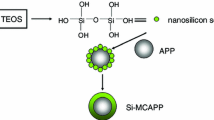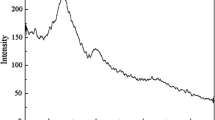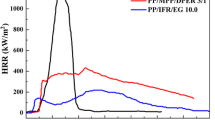Abstract
The more efficient and hydrophobic modificated ammonium polyphosphate (M-APP) and charring agent (M-CA) were prepared based on sol–gel method, and they were used in the preparation of water-resistant and flame-retardant polypropylene (PP) composites. The results showed that the contact angles of M-APP and M-CA were 135.11° and 137.89°, respectively. The flame-retardant and thermal properties of the PP composites were also studied. The results showed that the flame retardancy of PP loaded with 30 mass% intumescent flame retardant (M-APP/M-CA = 3:1) was significantly increased. The limiting oxygen index (LOI) reached 36.8% and passed UL-94 V-0. The peak heat release rate and total heat release of the PP composite decreased from 1011.77 to 134.43 kW·m−2 and 100.58 to 6.86 MJ·m−2, respectively. The peak smoke production rate and total smoke release decreased from 0.13 to 0.0056 m2·s−1 and 1453.09 to 74.82 m2·m−2. The PP composite with M-APP/M-CA = 3:1 also exhibited excellent water resistance, and it could still reach UL-94 V-0 after soaking in 70 ℃ water for 168 h.
Graphic abstract












Similar content being viewed by others

Availability of data and materials
Every data and materials exist in this manuscript are available.
References
Chen S, Li J, Zhu Y, Guo Z, Su S. Increasing the efficiency of intumescent flame retardant polypropylene catalyzed by polyoxometalate based ionic liquid. J Mater Chem A. 2013;1(48):15242–6.
Li J, Lai X, Li H, Zeng X, Liu Y, Zeng Y, Jiang C. Functionalized ZrP nanosheet with free-radical quenching capability and its synergism in intumescent flame-retardant polypropylene. Polym Adv Technol. 2019;31(3):602–15.
Sun Y, Yuan B, Shang S, Zhang H, Shi Y, Yu B, Qi C, Dong H, Chen X, Yang X. Surface modification of ammonium polyphosphate by supramolecular assembly for enhancing fire safety properties of polypropylene. Compos Part B-Eng. 2020;181:107588.
Feng C, Liang M, Jiang J, Huang J, Liu H. Synergistic effect of a novel triazine charring agent and ammonium polyphosphate on the flame retardant properties of halogen-free flame retardant polypropylene composites. Thermochim Acta. 2016;627:83–90.
Wang X, Wang Z, Li J. Effects of a semi-bio-based triazine derivative on intumescent flame-retardant polypropylene. Polym Adv Technol. 2019;30(5):1259–68.
Xu S, Li SY, Zhang M, Zeng HY, Wu K, Tian XY, Chen CR, Pan Y. Fabrication of green alginate-based and layered double hydroxides flame retardant for enhancing the fire retardancy properties of polypropylene. Carbohydr Polym. 2020;234:115891.
Kim NK, Dutta S, Bhattacharyya D. A review of flammability of natural fibre reinforced polymeric composites. Compos Sci Technol. 2018;162:64–78.
Xing W, Wang X, Song L, Hu Y. Enhanced thermal stability and flame retardancy of polystyrene by incorporating titanium dioxide nanotubes via radical adsorption effect. Compos Sci Technol. 2016;133:15–22.
Zheng Z, Qiang L, Yang T, Wang B, Cui X, Wang H. Preparation of microencapsulated ammonium polyphosphate with carbon source- and blowing agent-containing shell and its flame retardance in polypropylene. J Polym Res. 2014;21(5):1–15.
Liu J-C, Xu M-J, Lai T, Li B. Effect of surface-modified ammonium polyphosphate with KH550 and silicon resin on the flame retardancy, water resistance, mechanical and thermal properties of intumescent flame retardant polypropylene. Ind Eng Chem Res. 2015;54(40):9733–41.
Chen, W.; Yuan, S.; Sheng, Y.; Liu, G., Effect of charring agent THEIC on flame retardant properties of polypropylene. Journal of Applied Polymer Science 2015, 132 (1).
Shao Z-B, Deng C, Tan Y, Chen M-J, Chen L, Wang Y-Z. Flame retardation of polypropylene via a novel intumescent flame retardant: Ethylenediamine-modified ammonium polyphosphate. Polym Degrad Stab. 2014;106:88–96.
Shi Y, Gui Z, Yuan B, Hu Y, Zheng Y. Flammability of polystyrene/aluminim phosphinate composites containing modified ammonium polyphosphate. J Therm Anal Calorim. 2017;131(2):1067–77.
Ding S, Liu P, Zhang S, Ding Y, Wang F, Gao C, Yang M. Preparation and characterization of cyclodextrin microencapsulated ammonium polyphosphate and its application in flame retardant polypropylene. J Appl Polym Sci. 2020;137(34):49001.
Li Y, Jiang J, Chen Z, Chen Z, Ni L. Preparation and characterization of microencapsulated aluminum hypophosphite and its performance on the thermal, flame retardancy, and mechanical properties of epoxy resin. Polym Compos. 2021;42(4):1818–34.
Zhu J, Lu X, Yang H, Xin Z. Vinyl polysiloxane microencapsulated ammonium polyphosphate and its application in flame retardant polypropylene. J Polym Res. 2018;25(4):1–7.
Yang X, Tu Q, Shen X, Pan M, Jiang C, Lai X, Xue J. Synergistic modification by mercapto hyperbranched polysiloxane and functionalized graphene oxide on the surface of aramid fiber. Polym Test. 2020;91:106783.
Nie S, Hu Y, Song L, He Q, Yang D, Chen H. Synergistic effect between a char forming agent (CFA) and micro encapsulated ammonium polyphosphate on the thermal and flame retardant properties of polypropylene. Polym Adv Technol. 2008;19(8):1077–83.
Kim J-H, Hossain SM, Kang H-J, Park H, Tijing L, Park GW, Suzuki N, Fujishima A, Jun Y-S, Shon HK, Kim G-J. Hydrophilic/hydrophobic silane grafting on TiO2 nanoparticles: photocatalytic paint for atmospheric cleaning. Catal. 2021;11(2):193.
Hu J, Fang Z, Huang Y, Lu J. Fabrication of superhydrophobic surfaces based on fluorosilane and TiO2/SiO2 nanocomposites. Surf Eng. 2020;37(3):271–7.
Tong W, Xiong D, Zhou H. TMES-modified SiO2 matrix non-fluorinated superhydrophobic coating for long-term corrosion resistance of aluminium alloy. Ceram Int. 2020;46(1):1211–5.
Ni J, Chen L, Zhao K, Hu Y, Song L. Preparation of gel-silica/ammonium polyphosphate core-shell flame retardant and properties of polyurethane composites. Polym Adv Technol. 2011;22(12):1824–31.
Tawiah B, Zhou Y, Yuen RKK, Sun J, Fei B. Microporous boron based intumescent macrocycle flame retardant for poly(lactic acid) with excellent UV protection. Chem Eng J. 2020;402:126209.
Wang W, Wang J, Wang X, Wang S, Liu X, Qi P, Li H, Sun J, Tang W, Zhang S, Gu X. Improving flame retardancy and self-cleaning performance of cotton fabric via a coating of in-situ growing layered double hydroxides (LDHs) on polydopamine. Prog Org Coat. 2020;149:105930.
Yan L, Xu Z, Wang X, Deng N, Chu Z. Preparation of a novel mono-component intumescent flame retardant for enhancing the flame retardancy and smoke suppression properties of epoxy resin. J Therm Anal Calorim. 2018;134(3):1505–19.
Si M, Feng J, Hao J, Xu L, Du J. Synergistic flame retardant effects and mechanisms of nano-Sb2O3 in combination with aluminum phosphinate in poly(ethylene terephthalate). Polym Degrad Stab. 2014;100:70–8.
Wu K, Song Y, Lu H, Wang Z. Flame retardancy and thermal degradation of intumescent flame retardant starch-based biodegradable. Compos. 2009;48(6):3150–7.
Zhang F, Zhang J, Sun D. Study on thermal decomposition of intumescent fire-retardant polypropylene by TG/Fourier transform infrared. J Thermoplast Compos Mater. 2009;22(6):681–701.
Dong H, Yuan B, Qi C, Li K, Shang S, Sun Y, Chen G, Zhang H, Chen X. Preparation of piperazine cyanurate by hydrogen-bonding self-assembly reaction and its application in intumescent flame-retardant polypropylene composites. Polym Adv Technol. 2020;31(5):1027–37.
Lai, X.; Yin, C.; Li, H.; Zeng, X., Synergistic Effect Between Silicone-Containing Macromolecular Charring Agent and Ammonium Polyphosphate in Flame Retardant Polypropylene. Journal of Applied Polymer Science 2015, 132 (10).
Feng P, Ma L, Wu G, Li X, Zhao M, Shi L, Wang M, Wang X, Song G. Establishment of multistage gradient modulus intermediate layer between fiber and matrix via designing double “rigid-flexible” structure to improve interfacial and mechanical properties of carbon fiber/resin composites. Compos Sci Technol. 2020;200:108336.
Zheng Z, Zhang L, Liu Y, Wang H. A facile and novel modification method of β-cyclodextrin and its application in intumescent flame-retarding polypropylene with melamine phosphate and expandable graphite. J Polym Res. 2016;23(4):1–17.
Guo D, Wang Q, Bai S. Poly(vinyl alcohol)/melamine phosphate composites prepared through thermal processing: thermal stability and flame retardancy. Polym Adv Technol. 2013;24(3):339–47.
Zheng Z, Liu Y, Dai B, Meng C, Guo Z. Fabrication of cellulose-based halogen-free flame retardant and its synergistic effect with expandable graphite in polypropylene. Carbohydr Polym. 2019;213:257–65.
Bourbigot S, Michel LB, Gengembre L. XPS study of an intumescent coating II. Application to the ammonium polyphosphate/pentaerythritol/ethylenic terpolymer fire retardant system with and without synergistic agent. Appl Surf Sci. 1997;120:15–29.
Zhang M, Ding X, Zhan Y, Wang Y, Wang X. Improving the flame retardancy of poly(lactic acid) using an efficient ternary hybrid flame retardant by dual modification of graphene oxide with phenylphosphinic acid and nano MOFs. J Hazard Mater. 2020;384:121260.
Zhou T, Xu H, Cai L, Wang J. Construction of anti-flame network structures in cotton fabrics with pentaerythritol phosphate urea salt and nano SiO2. Appl Surf Sci. 2020;507:145175.
Yang R, Ma B, Zhang X, Li J. Fire retardance and smoke suppression of polypropylene with a macromolecular intumescent flame retardant containing caged bicyclic phosphate and piperazine. J Appl Polym Sci. 2019;136(25):47593.
Acknowledgements
The authors deeply appreciate the Provincial Natural Science Foundation of Anhui (1908085J20, 2008085QE269), the National Natural Science Foundation of China (No. 51775001), the University Synergy Innovation Program of Anhui Province (GXXT-2019-027, GXXT-2020-079), Post-graduate’s Innovation Fund Project of Anhui University of Science and Technology (NO.2020CX2016), Natural Science Research Project of Universities in Anhui Province (KJ2020A0326) and Leading Talents Project in Colleges and Universities of Anhui Province.
Author information
Authors and Affiliations
Contributions
Wei Yang contributed to experiment, data curation, investigation and writing—original draft preparation. Xiang Dong contributed to visualization and writing—review and editing. Shi-bin Nie contributed to conceptualization, methodology, writing—review and editing and supervision. Ji-nian Yang contributed to conceptualization and methodology. Xiang-feng Zhang contributed to methodology and formal analysis. Xue-qiang Wu carried out measurements and contributed to formal analysis. Cheng-ye Fang carried out measurements. Hai-lin Su contributed to validation.
Corresponding authors
Ethics declarations
Conflicts of interest
No conflict of interest exists in this manuscript.
Additional information
Publisher's Note
Springer Nature remains neutral with regard to jurisdictional claims in published maps and institutional affiliations.
Rights and permissions
About this article
Cite this article
Yang, W., Dong, X., Nie, Sb. et al. Flame-retardant and thermal properties of highly efficient water-resistant intumescent flame-retardant polypropylene composites. J Therm Anal Calorim 147, 7323–7336 (2022). https://doi.org/10.1007/s10973-021-11038-0
Received:
Accepted:
Published:
Issue Date:
DOI: https://doi.org/10.1007/s10973-021-11038-0



